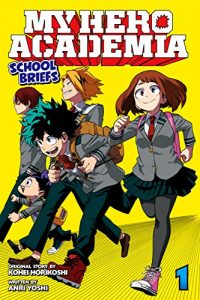By Kouhei Horikoshi and Anri Yoshi. Released in Japan by Shueisha. Released in North America by Viz Media. Translated by Caleb Cook.
I’m not sure if this is the final volume of School Briefs. But it’s certainly the last one to date, coming out in Japan in October 2021. The stories take place in that nebulous period after the internship with Endeavor but before the massive war that takes up the rest of the series. If there is another volume, it may wait till after the main series has ended, as light and fluffy stories really don’t fit with the current plotline, and there’s no “gap” to put them. If this is the final volume, it has the strengths and weaknesses of most MHA spinoffs. It tries to focus on characters who get less attention but doesn’t succeed that often, it can’t really affect any of the canon plotlines or characterization so tends to be fairly pointless, and it’s still trying to get us to like Mineta, which is simply not going to happen, sorry. That sad, there are a few stories here that proved to be a decent read, and that’s all you can ask for with a spinoff.
The stories are: 1) as part of a setsubun-themed training exercise, Bakugo is ordered to make friends with Eri, which requires him to not be a constant boiling cloud of rage, something that is very difficult for him; 2) The 1-A girls are making Valentine’s Chocolate, but are waylaid by a girl who wants them to give chocolate to 1-A’s Prince Charming”… whoever that is; 3) Several of the guys decide to use some of their break to go mountain climbing, since U-A happens to have its own snowy mountain range; 4) Eri has never celebrated Shichi-go-san day, and the desire to celebrate wars with her wavering sense of self-worth. Can Shinso and a cat help? 5) the business course students are making promo videos, and 1-A and 1-B are asked to act in them… much to their horror; 6) The UA teachers have a final drinking party and the book reminds us that Midnight is about to be killed.
I despised the Mineta chapter, partly as it got in the way of some (theoretical) Valentine’s shipping, but mostly as it wants us to find Mineta being a sexist creep funny. The best chapters were the ones that were allowed to focus on character, unsurprisingly. Eri’s attempts to be useful to her new family are heartwarming but also painful to see, reminding us of the trauma she’s been through in the past. Bakugo also does very well here, finally being forced to understand that Izuku reaching out his hand to help is not meant to be some sort of pity thing, but just who he is. This is a good setup for Bakugo’s eventual apology in the main series. As for the “video” chapter, it went on far too long, and was not all that funny, but we did manage to see Kodai say more words in this book than she has in the entire series. Likely as her video had to do with a magical girl team, which is lightly related to her sentai obsessions.
As noted, the novel ends with a bittersweet chapter showing Midnight giving everyone some expensive sake she bought, and reminding the reader that this is the end of the light, fluffy stuff. It lends gravitas to an otherwise up-and-down book.






